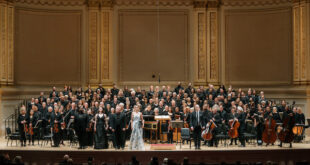One of the liveliest and most three-dimensional Bach recordings of recent years came out recently on Harmonia Mundi. Violinist Isabelle Faust, fresh off a superb Mendelssohn recording, has teamed with South African keyboardist Kristian Bezuidenhout to create an amazingly fresh-sounding rendering of Johann Sebastian Bach’s six Sonatas for Violin and Harpsichord (BWV 1014–1019).
In these works in trio sonata form, the harpsichord takes a second upper melodic line as well as the bass line. The two instruments are thus featured equally, and if you listen without paying close attention to the faster movements you could easily think there are three or more instruments going. Yet the two virtuosi play as one. In the Allegro second movement of Sonata No. 2, for example, the simultaneous twirling lines feel almost superhumanly synchronized.
The slow, mournful opening movement of Sonata No. 1 in B minor has all of that ineffable beauty Bach was able to deploy with such seeming ease. Yet in the third movement of Sonata No. 2, despite its minor key, Faust and Bezuidenhout convey a sense of almost lighthearted playfulness. Throughout the album they strike a fine balance between gravity and danceability, both qualities evident in pieces like the thoughtful second movement Allegro of No. 4.
Heard in concert, harpsichords often have a thin sound, but this recording captures the keyboard with a rich three-dimensional quality, almost as if we are not only in the room with the musicians but inside the very keyboard itself. This enhances the solemnity of movements like the Adagio of No. 4 as well as faster pieces like the scampering last movement of No. 1, the final movement of No. 3, and the first of No. 6.
 In his liner notes Bezuidenhout writes that the newer harpsichords of the period beginning around 1719 “galvanise[d] Bach into unlocking previously undreamt of realms of keyboard colour. Crucially, [Bach] also grasps that a sound of such richness can serve as the cornerstone for a new genre in which the harpsichord can be the true partner to a solo instrument like the violin.”
In his liner notes Bezuidenhout writes that the newer harpsichords of the period beginning around 1719 “galvanise[d] Bach into unlocking previously undreamt of realms of keyboard colour. Crucially, [Bach] also grasps that a sound of such richness can serve as the cornerstone for a new genre in which the harpsichord can be the true partner to a solo instrument like the violin.”
Bezuidenhout’s notes, as well as Peter Wollny’s, are well worth a full reading. It’s too easy to relegate the harpsichord to a quaint corner of history in the shadow of its younger, more robust cousin, the piano. But we should remember that the harpsichord had and has its own rich tradition, and Bach, the greatest composer of the harpsichord era, had very fine instruments at hand. It’s as much of a pleasure to hear Bezuidenhout play the keyboard heard here, made by John Phillips after Johann Heinrich Gräbner (1722) – listen to his deft touch in the solo-harpsichord third movement of No. 6, for example – as it is to revel in the sound of Faust’s 1658 Jacobus Stainer violin in, say, the same sonata’s muscular final movement.
All told, these are some of Bach’s most compelling and beautiful works, and it’s hard to imagine a finer performance than this. A recording that should stand as an aspirational ideal for future musicians, it’s available now on two CDs and digitally.
The musicians discuss these pieces, and other matters, in the video below.
 Blogcritics The critical lens on today's culture & entertainment
Blogcritics The critical lens on today's culture & entertainment



